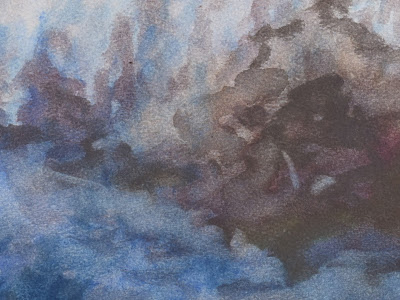Brown is the most fascinating and least popular color. The
best way to enjoy it is to surrender into its universe of variations. Of course
being a bit recessive brown benefits from extroverts like yellow.
Why shouldn't brown be as warmly regarded as any other
color? Part of its problem is associative: brown indicates that green things,
the upside of organic life, have expired.
Associations aside, a clear-eyed look at a brown leaf may
find it more beautiful and interesting than its recent prominence in green.
When plant leaves cease their production of chlorophyll
their green coloration reduces or ends. Yellow and red pigments that have been
masked by chlorophyll's vitality may briefly come to prominence (fall
coloration), along with new, temporary purplish pigments associated with
completion of the leaf's biologic role. This purplish surge generates the
exuberant part of the autumn brown landscape. The recessive part comes not from
living tissues but from the celluloid structures within leaves and other parts
of the plant, that eventually crumble to humus.
When brown sings it receives respected names from the world
of fashion: beige, taupe, mocha, cinnamon, écru.
Many of the favored names come from animals that adopt brown protectively.
Brown is the color that plant life takes in consolidation
for solemn, enduring functions like wood. But it is also the color of decay and
mud and excrement, stuff under foot, the devolved color of humus, the reduction
of the organic rainbow. After brown comes black: darkness, the end of the life
force.
You can begin taking delight in brown by mixing any primary color
with its complement. Pick a point on this color wheel and combine it with the
hue that waits diametrically opposite on a line through the center of the
wheel. In a wet paint exercise you'd concoct one of the infinite shades of brown
as you vary the proportions of the three primaries, along with white and black.
Most of the browns you'll encounter on a walk in the vegetative
world are warm browns from the yellow-red side of the spectrum tinged with a
little blue. Blue itself is relatively rare in nature except in the sky (and
its reflection in water), so we seldom see the cooler browns deriving from
blue, except in certain flowers. Painters, decorators, and fashion designers
can use mineral-based (inorganic) blue pigments to explore the realms of brown
as the iris does. Iris, the goddess of the rainbow.
On another pathway to brown at Halibut Point, light mixes reflected
yellows and reds onto the blue surfaces of water where it is admired by people
of many hues.
In its full range the color brown adorns the diverse
vitality of life.










Brown will never be the same to my eye
ReplyDeleteI think you have a bit of Leonardo Da Vinci in you, Martin....and I am reading the new book about him which is really fascinating.
ReplyDelete